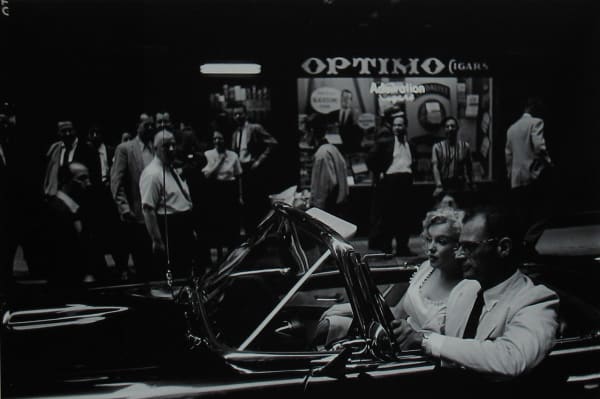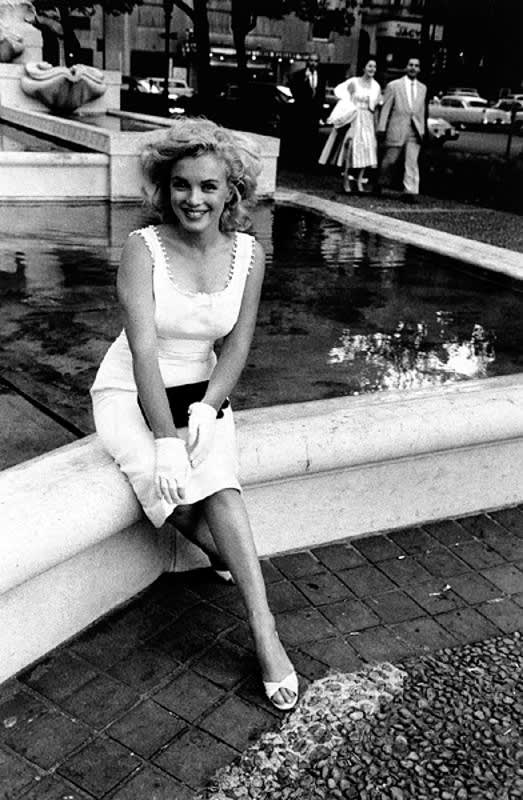Sam Shaw: Marilyn Monroe, The New York Years
-
 Sam Shaw, Marilyn Monroe on the set of The Seven Year Itch, 1954
Sam Shaw, Marilyn Monroe on the set of The Seven Year Itch, 1954 -
 Sam Shaw, Marilyn Monroe on Fifth Avenue, New York City, 1956 (printed later)
Sam Shaw, Marilyn Monroe on Fifth Avenue, New York City, 1956 (printed later) -
 Sam Shaw, Marilyn Monroe in Central Park, NYC, 1957
Sam Shaw, Marilyn Monroe in Central Park, NYC, 1957 -
 Sam Shaw, Marilyn Monroe and Arthur Miller driving in her 1956 Ford Thunderbird, New York City, 1957
Sam Shaw, Marilyn Monroe and Arthur Miller driving in her 1956 Ford Thunderbird, New York City, 1957
-
 Sam Shaw, Arthur Miller and Marilyn Monroe, Roxbury, CT, 1957
Sam Shaw, Arthur Miller and Marilyn Monroe, Roxbury, CT, 1957 -
 Sam Shaw, Marilyn Monroe and Arthur Miller cruising in his 1956 Ford Thunderbird, New York City, 1956 (printed later)
Sam Shaw, Marilyn Monroe and Arthur Miller cruising in his 1956 Ford Thunderbird, New York City, 1956 (printed later) -
 Sam Shaw, Marilyn Monroe at the Plaza Fountain, New York City, 1954 (printed later)
Sam Shaw, Marilyn Monroe at the Plaza Fountain, New York City, 1954 (printed later) -
 Sam Shaw, Marilyn Monroe, Roxbury, CT, 1957 (printed later)
Sam Shaw, Marilyn Monroe, Roxbury, CT, 1957 (printed later)
Sam Shaw is known for the celebrated photographs he took of Marilyn Monroe, whom he met in the early 1950s, when he was working as a photographer on the set of Viva Zapata. They became close friends and Marilyn drove Sam to the set every morning. The period 1954 to 1958 was a time when Marilyn tried to shed her blonde sex bombshell image and moved to New York to study acting. The exhibition photos show the screen icon in some of her happiest, off-guard moments, cuddling with playwright Arthur Miller, who became her third husband in 1956, in Roxbury, CT, shopping in Manhattan or splashing at the beach in Amagansett, NY. In 1954, it was Sam who suggested the famous sequence of Marilyn Monroe's skirt blown up over a street grate, in "The Seven Year Itch".
When asked about Sam Shaw, Marilyn said, "He always makes me look my best". When asked about Marilyn, Sam explained, "I just want to show this fascinating woman, with her guard down, at work, at ease offstage, during joyous moments in her life and as she often was - alone". Monroe died on August 5, 1962, but her image is preserved in Sam Shaw's photographs.
ABOUT THE PHOTOGRAPHER
Sam Shaw, born on the Lower East Side of Manhattan, was a man of the world, with a passion for art, photography and film. He began his artistic career as a sculptor and painter, while working in the atelier of Romare Bearden. He moved on to become the political cartoonist for the Daily Worker and then art director for the Brooklyn Eagle. In the beginning of the 1940s he was hired as a reporter and photojournalist for Collier's Magazine. Sam became known for his reportages of coal miners in West Virginia and stories on New Orleans jazz musicians, many of whom became his lifelong friends. By 1951, he had started working in the film industry as a specialized photographer; among his most celebrated images are the ones on the set of the movie "The Seven Year Itch", such as the iconic image of Marilyn over the subway grate. Sam traveled to many cities in the U.S. and Europe, absorbing local culture through his camera. He became intrigued with Cinécitta (Cinema City), considered the second Hollywood, located in Italy. After returning to the United States Sam became more involved in film and worked closely with Billy Wilder, Anthony Quinn, Marlon Brando and many other cinema legends. He worked closely with John Cassevettes producing a series of films where the actors created their characters on screen through improvisation.
Sam Shaw's photographic archives cover over 60 years of American history, from social essays, film documentation, icon figures and legendary personalities. His work has been exhibited internationally, in museums, galleries and art fairs, has been included in numerous traveling exhibitions and is in important institutional and private collections.










